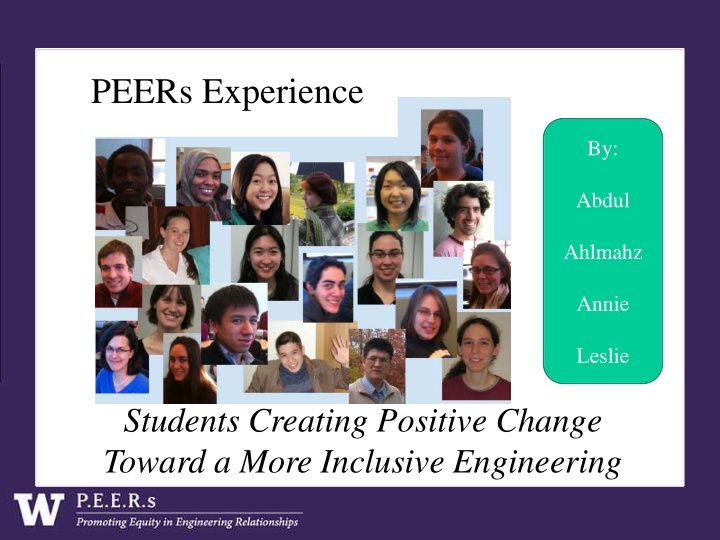



PEERs Experience By: Abdul Ahlmahz Annie Leslie Students Creating Positive Change Toward a More Inclusive Engineering
Overview •About PEERs •Current State of Engineering •Underlying Causes •Personal Stories & Why Diversity is Important •Discussion •Solutions
PEERs Seminar: Leadership Development to Promote Equity in Engineering Relationships Fall 2009
What Does Engineering Look Like Today on a National Level ?
2006 U.S. Population National Engineering Ages 18-24 by Bachelor’s Degree Ethnicity Enrollment Data Two or more races, non- Native Hispanic Hawaiian/Ot 2% her Pacific Islander 0% White 61% American Indian/Alask Hispanic/Lati a Native no 1% 18% Black/Africa n American Asian 14% 4% Source: National Science Foundation, Women, Minorities and Source: ASEE’s 2008 edition of the Profiles of Engineering and Engineering Persons with Disabilities in Science and Engineering, 2009. Technology Colleges (published in June, 2009). http://www.nsf.gov/statistics/wmpd/start.html http://www.asee.org/publications/profiles/upload/2008ProfileEng.pdf
National Engineering Enrollment Data Source: ASEE’s 2008 edition of the Profiles of Engineering and Engineering Technology Colleges (published in June, 2009). http://www.asee.org/publications/profiles/upload/2008ProfileEng.pdf
How do you think engineering enrollment at UW compares to the engineering enrollment nationally?
National Engineering 2007 UW Engineering Bachelor’s Degree Bachelor’s Degree Enrollment Data Awarded Data UW CoE Undergrad. Student Numbers Source: ASEE’s 2008 edition of the Profiles of Engineering and Engineering enrollment: 3,806 Technology Colleges (published in June, 2009). http://www.asee.org/publications/profiles/upload/2008ProfileEng.pdf degrees awarded 2007: 702
American Dream Game
Privilege • Unearned Advantage • Privilege can affect many different groups • Awareness is important for identifying privilege • Obstacles for minorities and women in engineering may not be experienced by every student
Examples of Privilege Gender & Economic Environment Race Status
Unconscious Bias
How does unconscious bias affect our actions? “Social scientists argue that most people have some degree of unconscious bias because it stems from our natural tendency to make associations to help us organize our social worlds.” Howard Ross, Exploring Unconscious Bias, www.diversitybestpractices.com
Example Studies: Study: Are there differences in recommendation letters written for males and females Results: • Letters for females : • Were shorter • Contained more criticism/faint praise • Included more gender terms Method: • Analyzed 312 recommendation letters for medical school faculty Source: Psenka & Trix, Wayne State University
Example Studies: Method: Results: Study: Tested the difference Blind auditions Sex-biased hiring for a blind auditions make in increased the likelihood symphony orchestra hiring practices in that a female would be symphony orchestras hired by 25%. Source: Rouse & Goldin (Orchestrating Impartiality) , Princeton and Harvard
Example Studies: Study: • Are Emily and Brendan more employable than Lakisha and Jamal ? • Tested the difference between resume callbacks for people with Method: “typically white” names and “typically black” names. • Resumes with “typically white” names received 50% more callbacks. • Highly skilled “typically white” names received more callbacks Results: than average. • Number of callbacks for highly skilled and average “typically black” names was virtually the same. Source: Bertrand and Mullainatha (Are Emily and Brendan More Employable?), University of Chicago and MIT
Engineering Stereotypes • White male • Good at math • Bad social skills • Wears big nerdy glasses • Consumes a lot of caffeine
Stereotype Threat “ Stereotype threat refers to being at risk of confirming, as self-characteristic, a negative stereotype ” (Steele & Aronson, 1995) reactance decreased performance internal attributions for failure task discounting altered professional identities and aspirations self-handicapping disengagement and disidentification distancing self from the stereotyped group
Groups Affected by Stereotype Threat Minority groups Gays and Women Lesbians Everyone! People with Men disabilities
Why Diversity is Important • Diversity provides valuable experiences and different perspectives which benefit the engineering community. • Diversity in engineering can reduce the effects of stereotype threat and increase awareness of privilege. • Engineers solves problems, and diverse groups create better solutions.
Discussion 1) What are your personal experiences? 2) Have you seen or experienced resistance to diversity?
Solutions Speak up when you Talk about diversity hear racist or sexist and its importance. comments or jokes. Be an Ally Be aware of your own Be proactive! Join unconscious bias: Try diversity groups and be out “Project Implicit” a role model or mentor
Recommend
More recommend